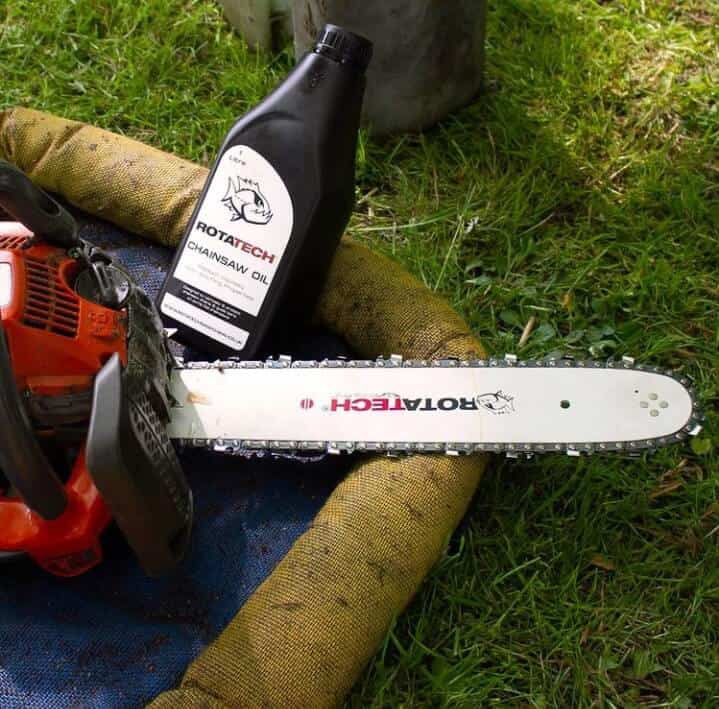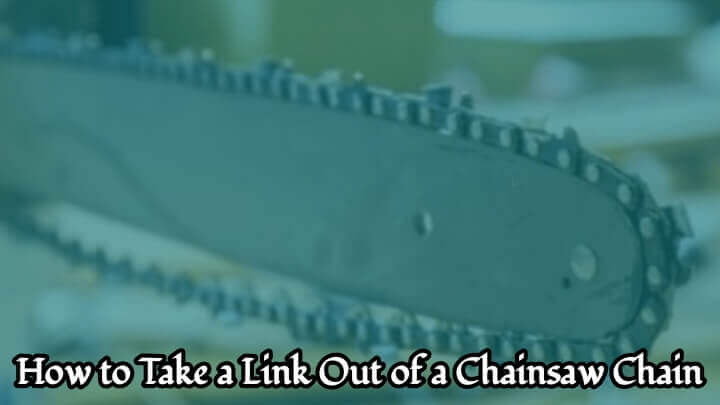The chainsaw chain is a fast-moving loop of sharpened steel that cuts through anything it touches. While it’s made for cutting down large trees and other wood objects, the power tool has been used for many different purposes, from removing an old brick to cutting up firewood.
This guide will show you how to take a link out of a chainsaw chain without damaging your saw or yourself in the process. This is an easy job at any level of experience with tools and should only take about three minutes if everything goes perfectly.
Table of Contents
If you follow all these steps, then taking a link out of a chainsaw chain should be no problem for you.
Step 1:
Get your materials together by gathering some oil, a rag, your manual if you have it, and of course, the chainsaw with the broken link removed. If there are any other details about your saw that might help clear your link, then be sure to gather this information too.
Step 2:
Remove the bar oil cap on top of it by turning it counterclockwise until it pops out. Set this off to the side for now. The bar is still attached, so there has not been any change yet.
Oil Up The Chain
Pull back some slack from your chainsaw rope (or pull cord) and soak it up with some WD-40. Just spray enough to all of it without soaking everything around you.
Pull Back And Soak
Locate the first cog of your chainsaw chain and put your oil-soaked rag on top of it. Now pull as tightly as possible on your chainsaw rope (or pull cord) to hold that cog there while you locate the second one by turning counterclockwise with a screwdriver or other flat object. You should feel some tension when you reach it but if not, keep spinning until you find it.
Locate Cogs And Oil Next Cog
Lube up the second cog with any oil. WD-40 works well because it’s easy to clean up later. Let go of the tension on your chainsaw rope (or pull cord) so that the cog you just pushed back in with the screwdriver or other flat object returns to its normal position. You should now see a clear opening in the chain where one of its links is broken. how to take a link
Lube Second Cog
Grab your pliers and slide them into the loop of metal that used to be attached to another link. Push down on one side until it pops out, then pull it completely off. If this proves too difficult, use your leg if it’s clean, don’t hurt yourself for this.
Open Up Space
Take your screwdriver or any other thin object and stick it between the chain where the link used to be. Push it down and pry against the sharp teeth of the broken offside. This should open up enough space for you to remove your second cog.[1]
Pry With A Screwdriver To Open Up Space

Remove your newly oiled cog by pulling it towards you until it slides out of place. You can see a small opening between two other cogs and no more links attached.
Remove The First Cog
Slide your pliers into that opening and pull as much slack as possible away from the chainsaw’s saw blade.
Tip: You can use either hand, but you should push with your off-hand using your dominant hand for stability. Safety is most important.
Grab Slack
Slide one edge of the pliers into that space as shown, and then use your off-hand as a brace as you lift on those teeth. Try to avoid pulling too hard at once because doing so can snap the chain in half.
Hold pliers tight
If you go slow and steady, there should be no problem taking a link out of a chainsaw chain. Keep doing this until it’s completely loose and falls away from your saw. Enjoy your newly freed-up extra power.
Benefits Of Taking A Link Out Of A Chainsaw Chain
Taking a few links out of an otherwise-new chainsaw chain can increase the performance, help prevent kickback and saw injury, reduce vibration, improve comfort/minimize fatigue during use, and extend the life expectancy of a chainsaw chain. Below, we will discuss each benefit in more detail.
1. Increased Cutting Speed
By removing only one or two links from a chainsaw chain, you can effectively double its RPMs without having to alter the depth gauge height or other components on the bar.
This improvement in cutting speed is felt immediately by anyone who uses it for this purpose. It allows even users with smaller saws (under 50cc) to cut through larger trees far more quickly.
2. Saw Kickback Reduction
The main advantage of shortening a chainsaw chain is reducing vibration and fatigue from the saw’s engine, as it no longer has to work against so much inertia from a longer, heavier chain spinning at higher RPMs.
This improvement is noticeable even on smaller 20-30cc saws. Removing links can also help reduce or eliminate kickback by allowing you to create a tighter cut against your body with every downward stroke of the bar.
This helps prevent accidental contact with nearby branches and limbs, which is another common cause of injury among chainsaw users.
3. Improved Comfort/Reduced Fatigue
Taking out only one or two chainsaw links also helps eliminate the tendency of a long chainsaw chain to bounce off the ground and up into your legs, causing bruising and fatigue. This is easily noticeable on small saws (20cc or less) and helps reduce vibrations on larger saws.
4. Improved Performance
Taking out only one link will barely affect the performance of most chainsaws. However, taking the first few links out of an otherwise-new chainsaw can improve its power by nearly 50% in some cases.
Older or poorly-maintained saws may be affected more significantly by this process, making their cutting speed 1/3 slower than it could have been with just one simple modification.
5. Extend Saw Chain Life Expectancy
When you shorten a chainsaw chain by one or two links, you can reduce the total amount of time required for a saw chain to become too dull to be helpful. In theory, every link in a chainsaw chain can cut through the wood just as well as any other link.
Therefore, removing only one or two from a brand-new chainsaw chain will have almost no effect on its overall lifespan.
6. Keep Each Cut Closer To Your Body
When you take a few links out of a chainsaw chain, this naturally brings the drive sprocket and engine further away from your body with each downward stroke of the bar. This can help prevent accidents caused when branches you didn’t fully see ahead of time contact your/ankle/knee/foot/etc. during a cut.
7. Reduced Vibration
Taking out only one or two links from any chainsaw chain will reduce the amount of vibration you feel after each consecutive downward stroke of the cutting bar, leading to less fatigue and longer comfort while being used for long periods at a time.
This is more noticeable on some chainsaws than others, especially those with smaller engines (20cc or less).
Summary
In conclusion, there are a number of possible ways to take a link out of a chainsaw chain. The first method should be the preferred mode because it is easier and safer than the other two methods.
However, if one does not have a rivet extractor or a drill that can mount the riveting tool, then using a drill press with a gear puller kit is probably their best bet. If this is still too difficult or impractical, they will need to heat the rivet until it comes to lose.

